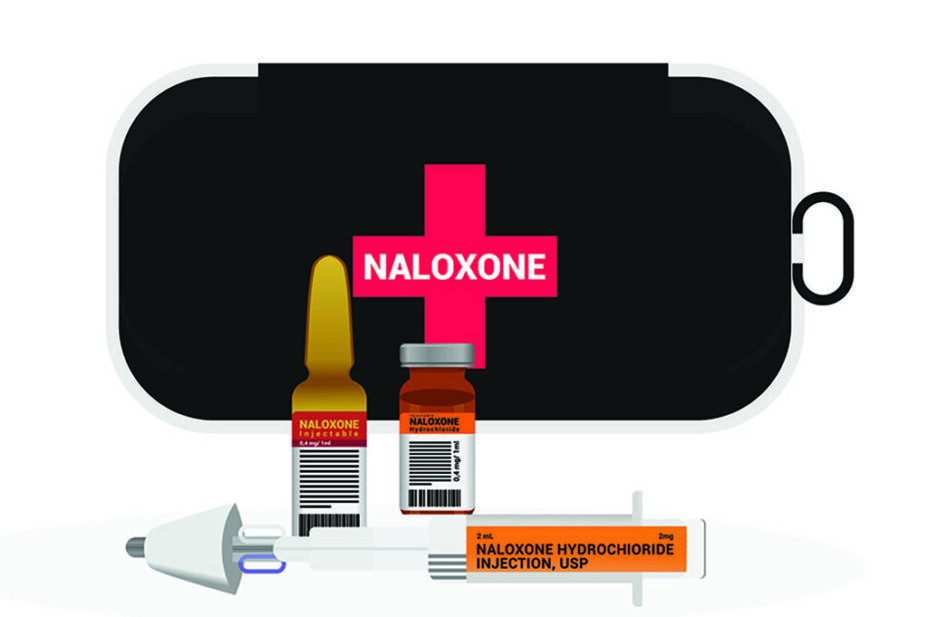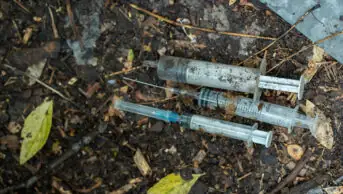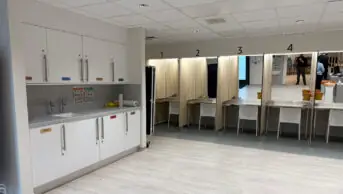
Shutterstock.com
A staggering 4,790 people died as a result of drug misuse in Great Britain in 2023, according to the most recent data from the Office for National Statistics (ONS).
ONS figures reveal that there were 3,618 drug-misuse deaths in England and Wales in 2023 — a 16% increase from 3,127 drug-misuse deaths in 2022.
At 61.8 deaths per million people, 2023 experienced the highest rate of drug-misuse deaths since records were first collected in 1993, when the figure stood at 15.7 deaths per million people1.
For deaths to be recorded as drug misuse, the underlying cause must have either been drug abuse or dependence — or the substances involved are illegal drugs — or both.
National Records of Scotland data show a total of 1,172 drug misuse deaths in 2023, or 224 deaths per million of the Scottish population, which is 3.5 times higher than the proportion of drug misuse deaths in England and Wales in 2023 and represents a 12% rise from the previous year2.
An important underlying factor for drug deaths is poverty, with people living in the most deprived areas of Scotland being more than 15 times as likely to die from drug misuse compared with those living in the least deprived areas.
Although drug classes are not always recorded on death certificates — so the figure can only be an estimate — it is evident from the data that, in Scotland, around 80% of fatalities in 2023 involved opioids.
In England and Wales, the ONS recorded figure was just under 50% of all drug poisoning deaths but this rises to just over 60% when deaths with no drug type recorded on the death certificate are excluded.
One way to tackle deaths from opioids is the immediate provision of the opioid antagonist naloxone (see Box). Naloxone displaces opioids that are bound to receptors in the brain for a short time, blocking their effects and reversing respiratory depression and loss of consciousness.
Naloxone is provided in two ways in Great Britain: as an emergency supply and as part of take-home naloxone (THN) kits, which can be given directly to drug users or to their family, friends or anyone who may be able to provide the antidote in case of an overdose.
Legally, anyone can use naloxone in an emergency. Users don’t have to be a clinician or have training; however, supplying naloxone is, of course, a different question.
Naloxone can be prescribed by a GP or drug treatment service; a small number of prisons provide naloxone to inmates on release; ambulance paramedics carry it; and community pharmacies providing other drug treatment services are able to supply it without prescription.
Possibly the biggest change for naloxone provision from a pharmacy perspective came in December 2024 when UK law was amended to make it legal for pharmacists and pharmacy technicians to provide THN kits without a prescription in an effort to widen access. Pharmacy professionals — as well as others including prison staff, registered midwives and registered nurses — were added to an existing list of professionals that were able to do this.
Box: Naloxone kits available for use in the UK
Naloxone is currently available for use in the community in the UK in two forms: an intra-muscular injection and an intra-nasal spray. There are three formulations currently with marketing authorisations in the UK for community, or non-clinician, use3:
- Prenoxad Injection (naloxone; Ethypharm), with each pre-filled syringe containing 5 x 0.4mg doses of naloxone — a total of 2mg;
- Nyxoid intranasal spray (naloxone; Napp Pharmaceutical), with each pack containing two applicators, each with a single dose of 1.8mg naloxone, roughly equivalent to 0.4mg intramuscular (IM) in the first ten minutes but reaching a higher plasma concentration thereafter, which is closer in equivalence to 0.8mg IM;
- Naloxone 1.26mg nasal spray, with each pack containing two applicators, with a lower dose of 1.26mg naloxone in each but also considered to be broadly equivalent to 0.4mg IM initially and 0.8mg IM in the longer term.
These three formulations of naloxone have a shelf-life of around three years, after which they should be replaced. There are no special storage requirements, and testing on naloxone subjected to extreme conditions has found minimal degradation even over extended periods of time.
Although naloxone can be supplied without prescription, it remains a prescription-only medicine subject to the other usual requirements for such medicines — for example, around labelling and record-keeping, and those supplying it should be able to demonstrate that it has been supplied appropriately, for use in an emergency. Suitable advice and training are required to enable services and professionals supplying and receiving naloxone to understand the product and how to use and store it safely4.
During the Westminster government’s 2024 consultation on altering the Human Medicines Regulations 2012, 96% of pharmacists who responded said they were “highly or somewhat likely” to keep a stock of naloxone if the regulations changed5.
However, as the government has admitted in its own guidance on implementing the change of law, published in April 2025, there is no compunction on community pharmacists to provide naloxone4. The newly enabled professionals can supply THN if they “want to (the power is enabling (or optional), not mandatory)”, the guidance explicitly states.
We aren’t anticipating seeing a massive change in the number of pharmacies providing the service
Vicki Roberts, service development manager, Community Pharmacy England
Experts say the community pharmacy network could use the law change to make sure naloxone reaches those who need it. Consequently, are we likely to see THN services become more widely available from community pharmacies in future?
Nationwide services
Community Pharmacy England (CPE) says it has had no discussions with the government about providing a nationwide community pharmacy THN service — largely owing to drug treatment services always being commissioned by local authorities.
Vicki Roberts, service development manager at CPE, tells The Pharmaceutical Journal: “We aren’t anticipating seeing a massive change in the number of pharmacies providing the service as a result of the change in the legislation and the guidance.
“But what it might do is, it might trigger some local pharmaceutical committees to have further conversations and discussions with their local commissioners as part of their ongoing conversations with those commissioners around supervised consumption and needle exchange.
“Ultimately, it will come down to funding and whether there’s sufficient funding in those funding envelopes for substance use services to be able to commission naloxone from pharmacies.”
Roberts says that the biggest demand for THN services is likely to be in areas where supervised consumption and needle exchange services are already provided.
“I can’t see it being commissioned as a sort of standalone service without some sort of relationship with the supervised consumption and needle exchange services,” she adds.
We know that the community pharmacy network in Scotland would be a great supply route for [take home naloxone kits]
Sarah Scott, policy and public relations pharmacist, Community Pharmacy Scotland
Sarah Scott, policy and public relations pharmacist at Community Pharmacy Scotland (CPS), says that, while tackling drug deaths is a huge priority in Scotland, there have been no moves there towards introducing a national THN service through community pharmacies.
“However, it would definitely be an ambition of ours, and that would hopefully look like something that includes training and onward supply. And for those who might need it, not just the supply element, but it would be able to use community pharmacy teams’ expertise,” she says.
“And certainly, we know that the community pharmacy network in Scotland would be a great supply route for that.”
A report on the availability of naloxone, published by the Advisory Council on the Misuse of Drugs in October 2023, highlights community pharmacy as an ideal vehicle to provide the medicine6.
Since 2015, 3,768 naloxone kits had been supplied by pharmacies contracted to supply naloxone by a community-based organisation in England, according to the report.
The report adds that a total of 717 kits supplied by pharmacies (19%) were administered following an overdose, compared with just 4% provided in an emergency by drug treatment services.
“This suggests that, in some parts of England, pharmacies are reaching those encountering overdose situations more often than drug treatment services,” the report says.
It concludes: “UK-wide agreement on the specific role of community pharmacies in supplying naloxone would be a useful way of promoting collaborative working in all areas of the UK.”
The reach of take-home naloxone
In Scotland, all community pharmacies have had to hold in stock at least two naloxone kits for use in emergency situations since the requirement was added to the community pharmacy public health service in October 2023.
This policy was introduced after publication of the final report from the Scottish Drug Deaths Taskforce in July 2022, which recommended that, as well as all community pharmacies holding naloxone for emergency use, they should all be able to supply THN7.
No central figures are held for the number of kits distributed from Scottish pharmacies under the naloxone emergency supply service.
However, for THN, the most recent annual data from Public Health Scotland, published in February 2024, show that there was a big jump in provision from 2020/2021, when 22,378 kits were issued — then the highest number since 2011 when kits were first provided — to 2021/2022, when 29,075 kits were provided. There was a slight drop in 2022/2023, when there were 28,689 kits issued8.
Public Health Scotland suggests two reasons for the big jump in THN supply over the past two years: a government and Scottish Drugs Forum campaign to promote the supply of THN kits through the charity Scottish Families Affected by Alcohol and Drugs and the launch of a national peer network to enhance the supply of THN via people with lived experience of drug use.
In addition, Public Health Scotland estimates that up to April 2023, the ‘reach’ of THN — based on the number of people at risk of an opioid overdose who were supplied with kits between 2011/2012 and 2022/2023 — was 705 kits per 1,000 people with problematic drug use or 70.5%.
In England, older data for 2016/2017, obtained under the Freedom of Information Act by drugs charity Release, found that the ‘reach’ for THN provision was just 12%.
Data on 151 out of the then 152 local authority areas in England, published by Release in 2017, showed that, nationally, an average of 12 THN kits were given out for every 100 people using opiates9. No THN kits were provided in 18 local authority areas, and the highest reach was 49%.
The data also showed that 31% of local authority areas did not provide THN kits to people accessing needle and syringe programmes; 21% did not provide kits to opioid substitution therapy patients; and 24% did not provide kits to family, friends and/or carers of “at-risk” individuals.
Since the 2016/2017 figures were obtained, many more local authorities have commissioned naloxone provision, according to Waythrough, a charity that provides training packages for community pharmacies that provide a naloxone service — both emergency and take-home — in several areas across the country.
Not everybody who uses drugs is in treatment, and not everybody who uses drugs will want to go into treatment
Jon Findlay, national harm reduction lead, Waythrough
Jon Findlay, national harm reduction lead at Waythrough, says the organisation has yet to take advantage of the 2024 legislation change on THN because most pharmacies it works with already offer a commissioned drug service and can provide naloxone as an extension of that service.
However, he says, community pharmacies are vital to extending the reach of naloxone provision into geographical areas and cohorts of people that really need it.
“We have started working more with pharmacies, because not everybody who uses drugs is in treatment, and not everybody who uses drugs will want to go into treatment,” he says.
“So, pharmacies will see a group of people we will never see, who will access needle syringe provision, for instance, and so they have a reach that we don’t have. And it’s really, really important that that group of people is able to access potentially life-saving medicines that are really easy to use.”
Findlay explains that the charity initially began delivering training packages to pharmacies that were offering needle syringe provision.
He adds: “Then we opened up to those delivering supervised consumption because it is about the footfall, and we’re trying to meet people wherever they are.
“If someone is already going to the pharmacy to get their methadone or buprenorphine, or going to get sterile injecting equipment, then this is an added offer.
“We recognise that this is aimed and targeted at a specific group of people, so we want to follow that group of people to where they are. But [a THN service] might not be an attractive offer to all pharmacies, though, because they might not ever get to use it.”
Need to do more
The appearance of nitazenes in street drugs in recent years has caused huge concern. In October 2024, the government estimated that between 1 June 2023 and 31 May 2024, the form of synthetic opioid 2-benzyl benzimidazole — or nitazene — caused 179 deaths in England.
In January 2025, a coroner wrote to the Department of Health and Social Care in a prevention of future deaths report, calling for naloxone to be made more readily available after a man died having taken heroin that had been adulterated with protonitazene and metonitazene.
In March 2025, the Scottish Drugs Forum warned that multiple doses of naloxone may be needed to treat some patients who have taken drugs mixed with these synthetic opioids.
“We know that drug-related deaths are the highest they’ve ever been, and we know that we have the most contaminated opiate market that we’ve seen in the past 20 years, with the reduction in heroin and the increase in potent synthetic opioids,” says Findlay.
“This is why we need to keep doing more, not to reduce drug-related deaths, because that is really hard to do, but actually to reduce the increase in drug-related deaths.”
I hope the legislation change will get people to think about naloxone in the same way that they do about adrenaline
Barbara Zub, national pharmacy technician, Waythrough
Barbara Zub, a national pharmacy technician with Waythrough, is now working on a project in South Yorkshire that is studying how, and how often, naloxone is delivered via community pharmacies, with the data produced to be used to help design future models of provision.
The charity provides stickers that pharmacies can display in their windows announcing that they stock naloxone, which she says has been hugely helpful in out-of-hours pharmacies that are open late into the evening and at weekends.
Since the pharmacies the charity works with are offering THN kits, Zub says the training they give to pharmacy staff has to be about more than just provision of the medicine by pharmacists and pharmacy technicians.
“Family and friends can also come in and talk about it and be trained in an emergency because it is very unlikely that that person [using opioids] will [administer naloxone] when they are overdosing,” she says.
“What I hope the legislation change will achieve is to get people to think about naloxone in the same way that they do about adrenaline. [Naloxone is] a life-saving drug but it’s no different to adrenaline, and hopefully having the medicine stocked more widely in community pharmacies and other settings that were added in the legislation, like midwives, will normalise it and make it seem just like taking another, easy-to-use, drug.”
Although the study in South Yorkshire has been operational for less than a year, Zub says that one of the pharmacies taking part, in Sheffield, has already saved six lives by providing naloxone.
She adds that it is this extraordinary potential to reduce the tragic number of drug-related deaths that makes it so important to introduce naloxone to as many community pharmacies as possible — and ideally as THN kits that can be used whenever and wherever an overdose happens.
Commenting on the naloxone provision in Scotland’s community pharmacies, Scott says: “Yes, it might not be the highest volume service or the highest activity service that has ever existed. It’s never going to compare to something like Pharmacy First, for instance. But the impact it has when it is accessed is immeasurable. When it is needed, it literally saves lives.”
- 1.Deaths related to drug poisoning in England and Wales: 2023 registrations. Office for National Statistics. October 23, 2024. https://www.ons.gov.uk/peoplepopulationandcommunity/birthsdeathsandmarriages/deaths/bulletins/deathsrelatedtodrugpoisoninginenglandandwales/2023registrations?utm_source=chatgpt.com
- 2.Drug-related deaths in Scotland in 2023. National Records of Scotland . August 20, 2024. https://www.nrscotland.gov.uk/publications/drug-related-deaths-in-scotland-in-2023/?utm_source=chatgpt.com
- 3.Draft Human Medicines (Amendments Relating to Naloxone and Transfer of Functions) Regulations 2024: Additional information from the Department for Work and Pensions. UK Parliament: Committees . August 16, 2024. https://committees.parliament.uk/publications/45294/documents/224369/default/
- 4.Supplying take home naloxone without a prescription. Department of Health and Social Care. April 23, 2025. https://www.gov.uk/guidance/supplying-take-home-naloxone-without-a-prescription#:~:text=Naloxone%20is%20a%20prescription%2Donly,a%20life%20in%20an%20emergency
- 5.Consultation outcome: Expanding access to naloxone: summary of feedback. Department of Health & Social Care. January 24, 2024. https://www.gov.uk/government/consultations/consultation-on-expanding-access-to-naloxone/public-feedback/expanding-access-to-naloxone-summary-of-feedback
- 6.ACMD review of the UK naloxone implementation (accessible). Advisory Council on the Misuse of Drugs . September 26, 2023. https://www.gov.uk/government/publications/acmd-naloxone-review/acmd-review-of-the-uk-naloxone-implementation-accessible#community-pharmacies
- 7.Changing Lives: Our Final Report. Scottish Drug Deaths Taskforce . July 2022. https://drugstaskforce.knowthescore.info/wp-content/uploads/sites/2/2022/08/Changing-Lives-updated-1.pdf
- 8.National naloxone programme Scotland: annual Monitoring report 2021/22 and 2022/23. Public Health Scotland. February 20, 2024. https://publichealthscotland.scot/publications/national-naloxone-programme-scotland-annual/national-naloxone-programme-scotland-monitoring-report-202122-and-202223/
- 9.Take-home Naloxone in England. Release. December 18, 2017. https://www.release.org.uk/blog/take-home-naloxone-england


